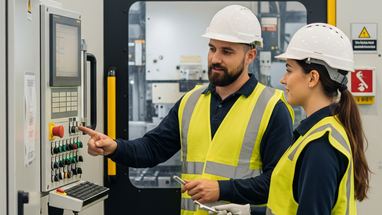Jul 10th 2025
Can You Series Wire Multiple Safety Switches? A Key Question for Industrial Control Systems
From emergency stop buttons (E-stops) to safety gate interlocks, ensuring machinery comes to a safe stop when needed is non-negotiable. For many industrial control distributors and their customers, a common question arises: "Can I wire multiple safety switches in series to my safety relay inputs?"
The short answer is: Yes, you can! However, like many things in safety, the "how" and the "why" come with crucial considerations. Let's delve into the details.
Why Series Wiring?
Wiring multiple safety devices in series can be an attractive option for a few reasons:
-
Simplicity: It can simplify wiring, especially for machines with several scattered safety points.
-
Cost-Effectiveness: Potentially reduces the number of safety relay inputs required, which can save on hardware costs.
The Mechanism: Dual Channel Redundancy
Most safety relays are designed with dual-channel inputs for redundancy. This means they monitor two independent circuits. When wiring safety switches in series, each switch typically has two normally closed (NC) contacts. These contacts are then wired into the two separate channels of the safety relay's input. If either contact opens (or a wire is cut), the safety relay detects the interruption and immediately brings the machine to a safe state.
The Critical Consideration: Fault Masking
While series wiring offers benefits, it introduces a significant challenge, especially with traditional "dry contact" or mechanical safety switches: fault masking.
Imagine you have several mechanical E-stops wired in series. If one of these E-stops has a contact that welds shut (a fault!), and then another E-stop in the series is pressed, the machine will still stop. The problem? The welded contact on the first E-stop remains undetected. This "masks" the fault, reducing your system's diagnostic coverage and potentially lowering its Performance Level (PL) or Safety Integrity Level (SIL) as defined by standards like ISO 13849-1.
How to Mitigate Fault Masking:
-
Embrace Electronic Safety Switches with OSSD Outputs: Modern safety devices like some RFID gate switches, light curtains, or laser scanners often come with OSSD (Output Signal Switching Device) outputs. These electronic signals are self-monitoring and often pulsed, designed to detect internal faults, short circuits, and open circuits. Wiring OSSD devices in series generally maintains a higher safety level due to their built-in diagnostics.
-
Utilize Diagnostic Pulse Testing: Some advanced safety relays incorporate diagnostic pulse outputs. These pulses help to actively check the integrity of the wiring and connected devices, even with mechanical contacts, thus improving fault detection.
-
Limit Devices in Series (for mechanical contacts): While there's no universal hard limit, wiring too many simple mechanical switches in series can severely degrade your diagnostic coverage. It becomes harder to meet the fault detection requirements of higher PL/SIL levels.
-
Consider Safety PLCs or Configurable Safety Relays: For complex machines or those requiring higher safety levels, a safety PLC or a multi-functional configurable safety relay is often the superior solution. These devices typically offer:
-
Multiple Independent Inputs: Each safety device can be wired to its own input, eliminating fault masking concerns.
-
Enhanced Diagnostics: They can pinpoint exactly which E-stop was pressed or which gate was opened, simplifying troubleshooting and reducing downtime.
-
Flexibility: Easily adapt to future machine modifications or expansions.
-
Other Practical Considerations:
-
Voltage Drop: For very long series circuits, especially with devices that have internal electronics or LEDs, voltage drop can sometimes be an issue. However, this is less common with simple dry contact switches.
-
Troubleshooting: While installation might seem simpler, troubleshooting a fault in a series circuit can be more challenging. Without individual input monitoring, isolating the exact faulty device or wire segment can take more time.
The Bottom Line
Yes, series wiring multiple safety switches to a safety relay is technically possible and widely practiced. However, it's critical to conduct a thorough risk assessment and understand the implications, particularly regarding fault masking when using mechanical switches.
For optimal safety, enhanced diagnostics, and simplified troubleshooting, especially in systems with higher safety requirements or a significant number of safety devices, consider utilizing modern electronic safety devices with OSSD outputs or investing in safety PLCs or configurable safety relays with individual inputs.
Always consult relevant safety standards (e.g., ISO 13849-1, IEC 62061) and consider your specific application's risk assessment when designing your safety circuits.
Need help designing your machine's safety system or selecting the right safety components? Contact us today – our experts are ready to assist you in building a safer, more efficient industrial environment!

